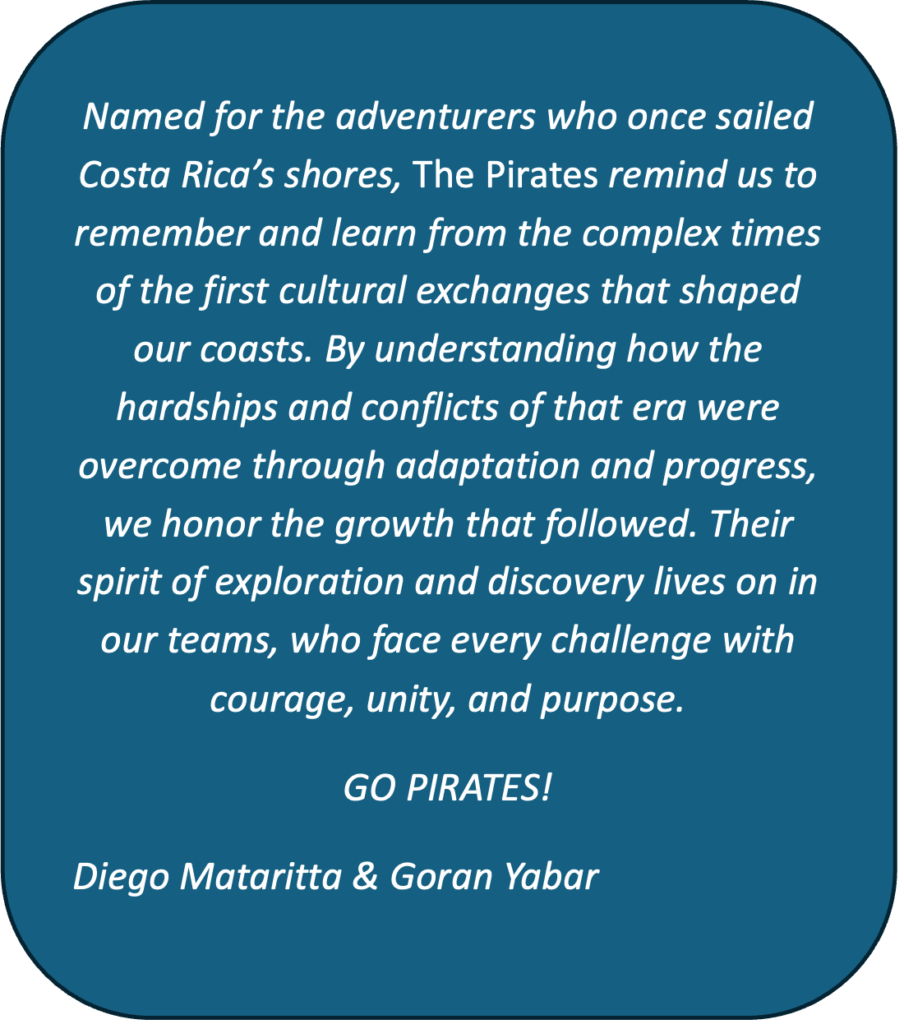A Name Rooted in History
In 2003, CRIA students chose to name our athletic teams The Pirates, a decision that still captures the imagination of our community today. The name reflects Costa Rica’s maritime heritage, stretching back to the 16th and 17th centuries, when explorers, merchants, and privateers sailed both the Pacific and Caribbean coasts.
Far from glorifying the darker aspects of piracy, the choice celebrates the enduring human qualities of courage, curiosity, adventure, and resilience—traits that also define our students and athletes.
And the story behind the name is also an opportunity to explore a fascinating chapter of world history — when explorers, privateers, and empires competed across the Caribbean and Pacific, shaping the lands and cultures of Costa Rica in lasting ways.
Why the Age of Pirates Emerged
From the 1500s to 1700s, European powers — Spain, England, France, and the Netherlands — raced to control trade routes, colonies, and wealth from the Americas.
Ships carried gold, silver, and goods across the seas, and along these routes arose the figures known as privateers (licensed by their governments) and pirates (independent adventurers).
Costa Rica, with its long coastlines and strategic location, found itself at the intersection of this maritime rivalry — its ports, rivers, and islands becoming stopovers, hideouts, or even battlegrounds.
While the word “pirate” often evokes images of chaos or lawlessness, their world reveals a far richer story — one of exploration, ambition, and human resilience in an age when the world’s great oceans became bridges of cultural contact.
Pirates and Privateers in Costa Rican History
Costa Rica’s geography made it a natural waypoint for early maritime activity. The following coastal areas carry the history, folklore, and legend of the Age of Pirates — ideal for students to connect past and place:
🏝 Isla del Coco (Cocos Island – Pacific Ocean)
- The most famous pirate-legend site linked to Costa Rica.
- Cocos Island’s remote location and dense jungle made it an ideal hideout for 17th- and 18th-century privateers.
- Legends tell of buried treasure, including the mythical Treasure of Lima, and explorers have found inscriptions carved by sailors along Chatham Bay’s rocks.
- Today, the island is a UNESCO World Heritage Site, protected for both its natural and historical value — a real-life classroom in the intersection of history and ecology.
⚓ Bahía Drake (Drake Bay – Osa Peninsula)
- Named for Sir Francis Drake, the famed English privateer who challenged Spanish dominance in the Pacific.
- Local legend holds that Drake anchored in this bay during his 1579 expedition.
- The area’s name and stories serve as living reminders of how early exploration connected Costa Rica to the wider world.

⚓ Manuel Antonio (Central Pacific Coast)
- The rugged cliffs and coves of Manuel Antonio are steeped in tales of hidden caches and shipwrecks.
- Though no treasure has ever been confirmed, the geography itself tells the story — secluded bays and forested headlands that once offered safe harbor to passing ships.
- The stories endure as symbols of imagination, risk, and exploration.
⚓ Matina River and the Caribbean Coast
- The Caribbean side also felt the impact of the pirate era.
- In 1666, English privateers associated with Captain Henry Morgan sailed up the Matina River, launching one of the few recorded incursions into colonial Costa Rica.
- Spanish forces repelled the attack, but the episode illustrates how both coasts were drawn into global competition.
- The Matina Valley, near Limón, remains a region rich in historical memory — where jungle and river once met the ambitions of rival empires.
⚓ Cahuita and the Southern Caribbean
- The coast near Cahuita National Park preserves shipwrecks and maritime lore dating back to the colonial era.
- Though many were merchant or transport vessels, the region’s coral reefs and currents were part of the same seafaring routes that pirates once navigated.
- Local stories and archaeological finds provide a tangible link to Costa Rica’s early maritime world.
Why CRIA Students Chose
“The Pirates”
When our students chose The Pirates as CRIA’s team name, they were inspired not by the darker aspects of piracy, but by the determination and daring of those who set out across unknown seas.

Like those explorers, CRIA students and athletes show:
- Courage to take on new challenges
- Teamwork to navigate adversity
- Resilience to reach their goals
These values transform the name Pirates from a symbol of conquest into one of character and discovery — mirroring CRIA’s mission to
Think. Aspire. Achieve.
A Modern Reflection on an Age of Exploration
For today’s learners, the story of piracy is not about glorifying the past but about understanding it. The Age of Pirates teaches us about cultural interaction, global trade, and the human thirst for exploration — forces that continue to shape our world.
At CRIA, we celebrate The Pirates as a reminder that the pursuit of knowledge and excellence often begins with the same spirit that drove the explorers of history: curiosity, courage, and the desire to go further.

